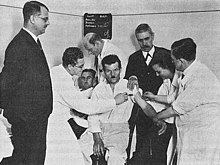Julius Wagner-Jauregg
Julius Wagner-Jauregg | |
|---|---|
Malariotherapy | |
| Spouse(s) | Balbine Frumkin (divorced 1903) Anna Koch (married 1899) |
| Children | Julia and Theodor |
| Awards | Nobel Prize in Physiology or Medicine (1927) Cameron Prize for Therapeutics of the University of Edinburgh (1935) |
| Scientific career | |
| Fields | Pathology Psychiatry |
| Institutions | University of Vienna University of Graz State Lunatic Asylum at Steinhof |
| Thesis | L'origine et la fonction du coeur accélére (Origin and function of the accelerated heart) (1880) |
| Doctoral advisor | Salomon Stricker |
| Signature | |
Julius Wagner-Jauregg (German:
Early life

Julius Wagner-Jauregg was born Julius Wagner on 7 March 1857 in Wels, Upper Austria, the son of Adolph Johann Wagner and Ludovika Jauernigg Ranzoni.[2] His family name was changed to "Wagner von Jauregg" when his father was given the title of "Ritter von Jauregg" (a hereditary title of nobility) in 1883 by the Austro-Hungarian Empire. Hence he retained the name Julius Wagner Ritter von Jauregg until 1918 when the empire was dissolved, and nobility was abolished. The family name was then contracted to "Wagner-Jauregg".[3] He attended the Schottengymnasium in Vienna before going on to study Medicine at the University of Vienna from 1874 to 1880, where he also studied with Salomon Stricker in the Institute of General and Experimental Pathology. He obtained his doctorate in 1880 with the thesis "L'origine et la fonction du cœur accéléré."[2] He left the institute in 1882.
After leaving the clinic, he conducted laboratory experiments with animals, which was practiced very little at this time.
Ten years later, in 1902, Wagner-Jauregg moved to the psychiatric clinic at the General Hospital and in 1911 he returned to his former post.
Criminal inquest
Wagner-Jauregg was angered by what he considered as the
Nobel prize

The main work pursued by Wagner-Jauregg throughout his life was related to the treatment of
In 1935, he was awarded the Cameron Prize for Therapeutics of the University of Edinburgh.
Involuntary sterilizations
Wagner-Jauregg administered thyroid and ovarian preparations to young psychotic patients who had experienced delayed puberty, which led to the development of their secondary sexual characteristics and diminished psychosis. Other patients were deemed
Retirement
In 1928, Wagner-Jauregg retired from his post but remained active and in good health until his death on 27 September 1940. In his retirement he published nearly 80 scientific papers.[2] Many schools, roads and hospitals are named after him in Austria.[citation needed]
Nazi ideology and affiliation
Towards his last days Wagner-Jauregg was influenced by
Wagner-Jauregg advocated a racial hygiene ideology called eugenics,[14] influencing students such as Alexander Pilcz, who went on to author a standard handbook on racial psychiatry critical of Jews for being prone to mental illness.[15]
He was also an advocate of forced sterilization of the mentally ill and criminal,[12] having endorsed the concept in 1935 while a member of the Austrian Anthropological Society.[16]
He was President of the Austrian League for Racial Regeneration and Heredity, which advocated sterilization for those of inferior genetics.[17]
See also
References
- ^ "The Nobel Prize in Physiology or Medicine 1927". Nobelprize.org. Nobel Media AB. Retrieved 20 March 2014.
- ^ ISBN 978-981-02-3410-2.
- ^ "Julius Wagner-Jauregg Biography (1857-1940)". Advameg, Inc. Retrieved 20 March 2014.
- ISBN 978-0-300-10729-6.
- PMID 16452338.
- PMID 24202157.
- ISBN 978-0-19-973746-8.
- ISBN 978-0-8135-4169-3.
- ISBN 978-0-300-12670-9.
- ISBN 978-0-226-50068-3. Retrieved March 16, 2010.
- ISBN 978-0-19-517668-1
- ^ ISBN 978-0-02-864310-6.
- ISBN 978-1-85463-012-4.
- ^ ISBN 978-3-211-48949-9.
- ISBN 978-0-8047-3262-8.
- ISBN 978-1-57113-420-2.
- ^ "Freud's foes: psychoanalysis, science, and resistance", Kurt Jacobsen. Rowman & Littlefield, 2009. p. 105. 0742522636, 9780742522633.
Further reading
- Magda Whitrow. Julius Wagner-Jauregg (1857–1940). London: Smith-Gordon, 1993.
- Neugebauer, Wolfgang / Scholz, Kurt / Schwarz, Peter (Hrsg.), Julius Wagner-Jauregg im Spannungsfeld politischer Ideen und Interessen - eine Bestandsaufnahme. Beiträge des Workshops vom 6./7. November 2006 im Wiener Rathaus (Frankfurt am Main u.a., Peter Lang, 2008) (Wiener Vorlesungen: Forschungen, 3).
External links
 Media related to Julius Wagner-Jauregg at Wikimedia Commons
Media related to Julius Wagner-Jauregg at Wikimedia Commons- Julius Wagner-Jauregg on Nobelprize.org including the Nobel Lecture on December 13, 1927 The Treatment of Dementia Paralytica by Malaria Inoculation
- Nazi past
